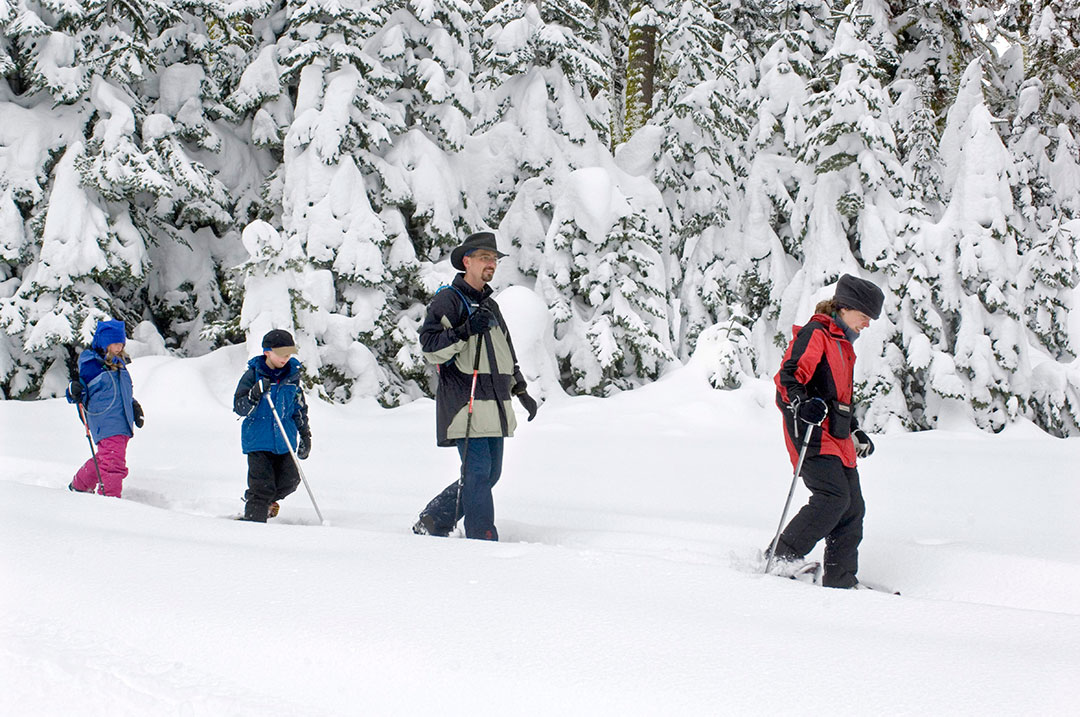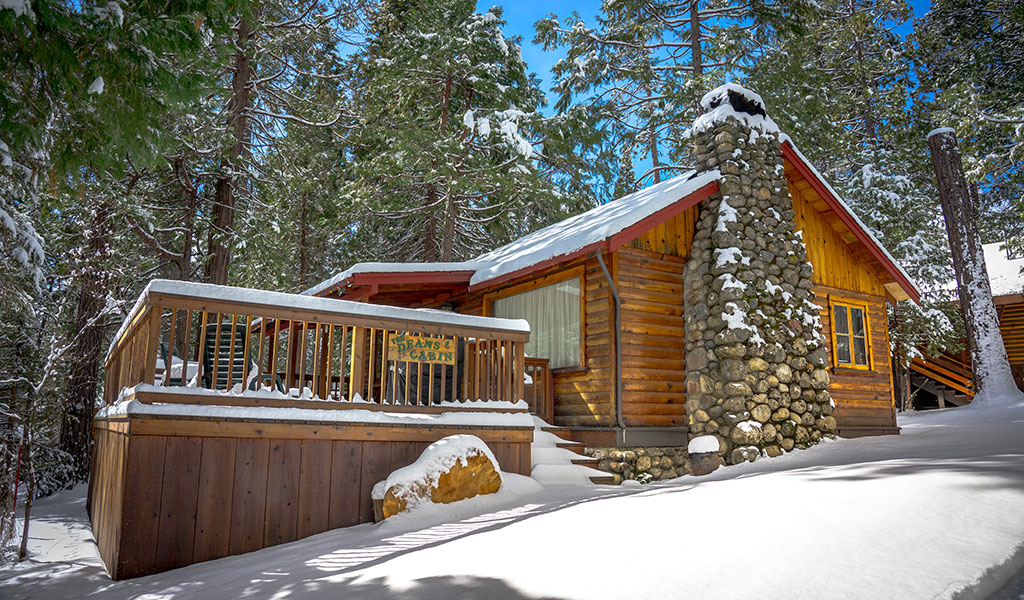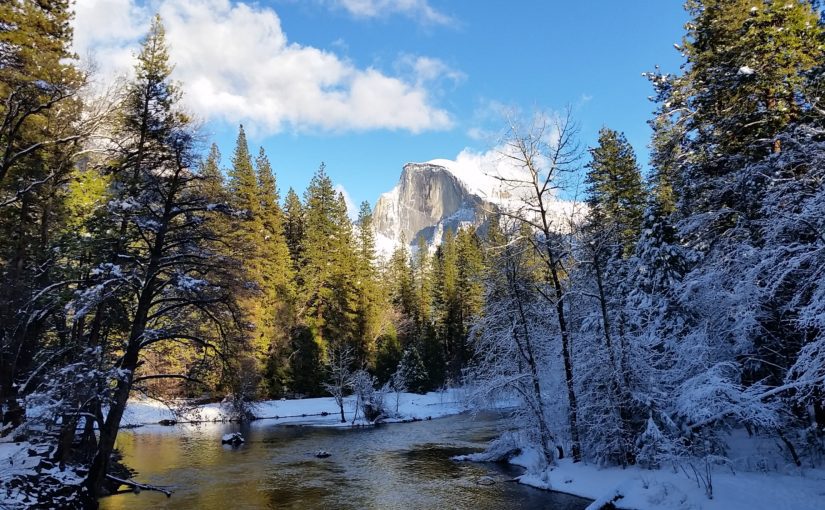Yosemite in January sleeps under a blanket of snow. The bears and squirrels and other hibernators have gone to ground. A feeling of quiet lies on the land. The holiday revelers are also gone making it easy to find quiet spaces where you can pause and reflect on the year, either solo or in the company of those closest to you.
There is plenty to keep you busy during the days, and the long winter nights mean that it is more important than ever to have some room to spread out in a warm and inviting Redwoods in Yosemite cabin.
In a typical January, the full set of Yosemite winter activities is on the menu from skiing and snowboarding at Badger Pass, to quiet exploration on cross-country skis or snowshoes, to ice skating, sledding, tubing, and of course, family game night with a warm cup of hot chocolate in a cozy cabin. At lower altitude, visitors to Yosemite in January can hike without any special equipment, enjoying the views of the classic Yosemite sights dressed up with accents of snow on the cliffs and peaks.
So grab your winter gear and come explore. If you don’t know Yosemite in winter, you don’t know Yosemite!
January Weather in Yosemite
January temperatures in Yosemite Valley and Wawona, both at an altitude of about 4,000 ft (1,200 m), clock in at an average high of 48°F (9°C) and an average low of 29°F (-2°C). Keep in mind that those are just averages. On a cold, snowy day, you will need a winter coat and hat and full winter garb, while on a warm, sunny day, you can find yourself relaxing in the sun in just a shirt and light pants.
As elevation increases, temperatures decrease. So, when you go up in altitude to places like the Badger Pass Ski Area, which ranges from 7,200 to 8,000 feet in elevation, you’ll find more wintry conditions. Because you can adjust the temperature by going higher or lower in elevation, it’s easy to find things to do at the perfect temperature.
January sees an average of 7.0 inches (177 mm) of precipitation, enough to recharge Yosemite Falls in most years and create the famous ice cone at the base. At higher altitudes, the majority of this precipitation falls as snow, opening up the full suite of winter recreation.
When snow accumulates on the road, particularly during snow storms, rangers could require vehicles to put on tire chains for extra traction. Because there are different levels of chain controls, the best way to avoid needing to install tire chains on your vehicle is to drive (or rent) a 4WD or AWD vehicle. Remember, though, that even if you are not required to put the chains on your wheels, state and federal law requires you to carry chains when entering a chain control area, even if you are in a 4WD or AWD. Learn the essentials of chain controls in Yosemite.
The best way to find out about current Yosemite road conditions is to call the hotline at 209-372-0200 (press 1 and 1 again) to listen to the recording.
Finally, just before your trip, make sure to check the interactive Current Conditions map on the NPS page for information on weather, forecasts, webcams, and more in different parts of the park.
What to Do in Yosemite in January
Downhill Skiing and Snowboarding
January is a special time for locals, because the Badger Pass Ski and Snowboard Area usually opens in time for Christmas. It can be busy over the holidays but come January, you often feel like you have the place to yourself. In addition, it is one of the most affordable ways in California to learn to ski or snowboard with attractive “learn-to” packages for both skiing and snowboarding. With lots of beginner-friendly terrain and all trails feeding into a central base area, Badger Pass is particularly enticing for families who want to introduce the kids to winter sports. It’s also just a fun, affordable place for any skier or snowboarder to lay down some turns and revel in the crystalline beauty of winter.
Cross-country Skiing
For more of a winter nature experience, cross-country skiing lets you venture far from the developed areas. With lighter boots that have a “free heel” and a patterned base that helps you grip the snow, cross-country skiing combines everything you love about hiking, with the fun of gliding downhill.
If you’re new to cross-country skiing, a lesson will get you off on the right ski! The Nordic Center at Badger Pass has rentals and instructors who can give you the tools you need to set off on your own adventures. Trails specifically groomed for cross-country skiing lead to Old Badger Summit, a relatively short and beginner-friendly tour. For those looking for a serious challenge and some of the most beautiful winter scenery in the world, the 21-mile round trip to Glacier Point will fit the bill. While this 21-mile round trip is only for very fit skiers, there is plenty of beautiful scenery along the way, such as the views of the Clark Range at about the halfway point. You can go turn around at any point. Just remember to save enough energy to get back!
In addition, marked but ungroomed ski trails lead to numerous destinations both near and remote. It’s about a 3.5-mile trip each way to Dewey Point with its incredible views across Yosemite Valley to El Capitan. For those comfortable navigating off trail, a deep bed of snow covers the underbrush and makes it possible to travel to places that are all but inaccessible in the summer as you quietly stride and glide above the bushes and fallen logs that normally block the way. Just make sure you know how to get back!
You’ll also find excellent opportunities for ungroomed cross country skiing at Crane Flat, and close to Wawona in the Mariposa Grove of Giant Sequoias. There are few things more awe-inspiring than a sequoia grove under a blanket of fresh snow.
Snowshoeing

In the winter season, snowshoeing becomes an easy way to explore the snowy landscapes of Yosemite National Park.
Cross-country skiing is not for everyone. It takes some practice before you can venture into challenging terrain. So, if you want to get out and experience the high-country beauty of Yosemite in January without investing that time, snowshoes are the ticket. Though it takes some getting used to, in a few minutes you’ll be walking anywhere your feet can carry you, buoyed up by a good pair of snowshoes.
To get started and learn about Yosemite’s winter environment, start with a guided ranger walk at Badger Pass. Or head out with a Yosemite Mountaineering School snowshoe guide for a more wide-ranging adventure. Once you have your confidence, then the entire Yosemite backcountry awaits you.
Cross country ski and snowshoe rentals are available locally at the Nordic Center, a smaller building across from the main lodge at Badger Pass.
Can You Hike In Yosemite in January?
With all this talk of snowsports, you might wonder whether Yosemite’s iconic hiking destinations are accessible in January. Yes they are!
Many hikes are perfectly accessible with little or no specialized equipment. Hikes around Wawona like the Wawona Meadow Loop and the Swinging Bridge hike are convenient choices for people staying at the Redwoods In Yosemite cabins. Also, the hikes on the floor of Yosemite Valley such as the Valley Loop Trail and Mirror Lake are also good winter walks.
The Yosemite Falls Trail will commonly have considerable snow at the top, but the hike to Columbia Rock yields wonderful views of the Valley and Half Dome. The best views of the falls are from about the halfway point on the trail and this is usually snow-free or packed out for easy walking. Though sometimes a bit icy, it melts out quickly once the sun gets to work on it.
The famous Mist Trail is closed in sections and hikers need to take the somewhat longer winter route that combines parts of the John Muir Trail with parts of the Mist Trail to make for a safe winter route.
It is often handy to have some sort of traction device for the feet such as “microspikes” as well as trekking poles. Even the low-elevation trails can have icy sections and the traction devices and poles can save you from a fall.
Photography and Sightseeing
Winter snows create some of the most stunning landscapes Yosemite has to offer. A blanket of white on the peaks and the play of winter light adds relief and drama to the views, making for excellent photos and excellent memories. When storms arrive, places like Tunnel View draw dozens of professional photographers seeking to capture the unique conditions of Yosemite in January.
All of the incredible and iconic viewpoints in Yosemite Valley are open year-round. After the first storms of the season, the waterfalls reappear and begin flowing again, and if you’re lucky enough to be there during a cold snap, you might even have a chance to see frazil ice.
Sledding and Snow Play
You don’t need an Olympic bobsled run to feel the thrill and joy of sliding downhill in the winter on nothing but a thin sheet of plastic. The kids love it, but the smiles on the parents show that sledding is not just for the kids. The small hills in Wawona Meadow provide gentle slopes for sledding, and the open spaces fill with snow people of all shapes and sizes.
There is also a designated snow play not far from Wawona, at Goat Meadow, just outside the park boundary with plenty of parking.
If you get up early, you might also find a place in a pull out along the road to Badger Pass Ski and Snowboard Area, though the parking there is very limited.
You can also go snow tubing (for a fee) at Badger Pass Ski and Snowboard Area, but sledding is not allowed at the ski area.
Outdoor Ice Skating
Imagine gliding across the ice on an outdoor rink with a view of Half Dome! The Curry Village ice skating rink lets you do exactly that. You can’t find a backdrop like that just anywhere!
The slightly smaller rink at Tenaya at Yosemite doesn’t have a view of Half Dome, but it does have a roof that provides more protection from the elements while still providing an outdoor feel among the tall pines, firs and cedars.
You can rent ice skates at either rink and both have a nice warm fire pit perfect for warming up or roasting marshmallows.
What’s Open (or not) in January in Yosemite?
The majority of Yosemite is open and accessible all year long. However, some roads and trails do close during the winter months.
The high-elevation Tioga Road that cuts through the park from east to west closes for the winter. That makes it a pretty long ski to Tuolumne destinations.
Beyond the Badger Pass Ski and Snowboard Area, Glacier Point Road turns into a groomed cross-country ski trail in the winter. Parking is available at Badger Pass once the ski area opens, but beyond that, you’ll need to ski or snowshoe 10+ miles (16 km) each way to visit the iconic overlook at the end of the road.
Those looking to hike to Vernal Fall or Nevada Fall in January should plan to take the Winter Route, which avoids the ice hazards of the Mist Trail and the Upper Ice Cut. And the 4-Mile Trail is closed at the gate near Union Point.
January Lodging in Yosemite (and Deals!)

Be sure to rent a vacation rental cabin from The Redwoods for your trip to Yosemite in January. Short days are nicer when you have a whole home to spread out in, and all Redwoods in Yosemite are located inside Yosemite National Park, so you’re close to the park attractions.
The Redwoods in Yosemite offers a full range of rental cabins from small to large, and from simple to lavish, so you can find a place to stay that fits your group perfectly.
Because January in Yosemite is truly a quiet season, it’s also a great time of year for availability and excellent lodging deals.
If you have a large group, consider renting one big house or multiple homes near each other. For really large groups, The Redwoods has a Wedding and Events Center that accommodates up to 100 people for group gatherings and 80 for formal dining. This can also be a great option for businesses or non-profits looking to strategize for the year ahead or families looking to celebrate special occasions.
Because your Redwoods in Yosemite cabin is located in the small community of Wawona, inside the park boundary, you’ll have great access to all that the park has to offer. That makes it easy to organize the crew for a day of park exploration.
With so much to do in Yosemite for all ages and activity levels. An unforgettable landscape like Yosemite sets the perfect scene for memories that will last a lifetime, and a tradition of gathering that will span generations.
Book that January trip now!

